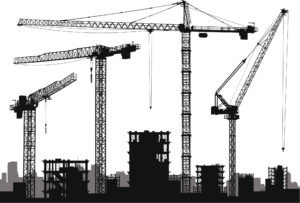The most typical kinds of crane mishaps include when the crane comes into touch with live power lines, when the load or equipment strikes a worker, when employees or operators fall from the crane, when the crane goes over, and when the boom or cable malfunctions.
These crane mishaps frequently result in catastrophic or fatal injuries. In fact, of all construction accidents, crane accidents are some of the most serious. Keep reading to learn more about how you can recover compensation for this type of accident and contact PLBH at (800) 435-7542 for help with workers compensation and other areas of workplace accident law.
What are the primary factors that lead to crane accidents?
In the construction business, crane accidents are a very uncommon type of workplace mishap. But when they do occur, the injuries are frequently serious or fatal. Crane accidents do not occur frequently, making it challenging to compare the frequency of their causes.
Moreover, many crane mishaps go unreported to the Occupational Safety and Health Administration (OSHA) or the Bureau of Labor Statistics (BLS). It is impossible to precisely anticipate what is most likely to cause an accident without a complete list of the accidents.
Yet, one study indicated that the following were the most typical causes of the 571 fatal crane accidents that occurred between 2000 and 2009: electric shock, a worker who was hit by or entangled in equipment, a crane load struck a worker, a crane tipped over, a worker crushed during assembly or disassembly, failure of the boom or cable, or a worker struck by something other than the crane’s weight or equipment.
Several factors could be to blame for non-fatal crane accidents. These occurrences, however, are less likely to be reported to OSHA. Yet, they frequently result in severe injuries.
Crane accidents often involve electrocution
A crane’s boom or load line coming into contact with a live electrical wire can result in an electrocution that might be lethal for anyone touching the equipment. The riggers who are clinging on a crane are particularly at risk in this situation. But crane operators who attempt to exit their cab risk electrocution as well.
When the crane is in motion, electrical shocks are most likely to occur. Smaller mobile cranes are typically utilized in constrained spaces where overhead power wires are dangerous. The boom could swing and strike one of these cables if the operator is not careful.
Worker falls from a crane
Fatal falls are frequently caused by crane mishaps. This can occur in construction settings where the worker is elevated and is typically anchoring steel beams for a building’s higher stories. If the worker is not safely secured or tied down and the crane jostles the beam they are on, they may lose their balance and fall. As tower cranes are being assembled or disassembled, worker falls can also occur.
Who is accountable in a crane accident?
There are numerous individuals and organizations that can be held accountable for injuries sustained in a crane disaster. The specifics of the crane accident will determine who is really at fault. Often held accountable parties include the following: crane manufacturer, crane operator, maintenance personnel in charge of checking or maintaining the crane, or the architect or engineer of the construction project.
To find out how might be held accountable in your particular case, contact PLBH at (800) 435-7542 for a free legal consultation.

